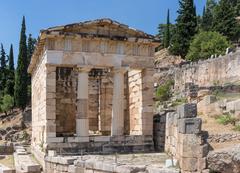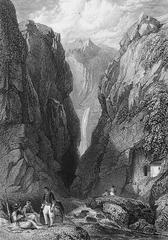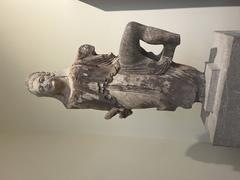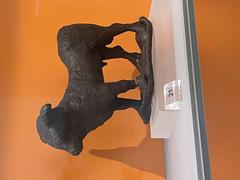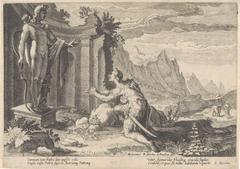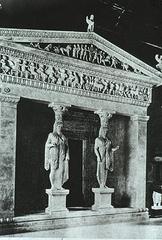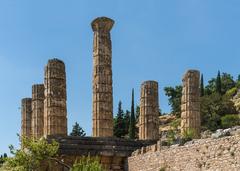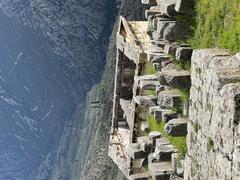
Visiting the Gymnasium at Delphi, Greece: Hours, Tickets, and Historical Significance
Date: 04/07/2025
Introduction
The Gymnasium at Delphi is an enduring emblem of ancient Greek civilization, uniquely encapsulating the harmonious blend of athletic, educational, spiritual, and civic pursuits that characterized classical Greece. Established in the 4th century BCE on the sacred slopes of Mount Parnassus, it played a pivotal role in preparing athletes for the prestigious Pythian Games and functioned as a vibrant center for intellectual discourse and social interaction. Today, the Gymnasium stands as a testament to the Greek ideal of paideia—the balanced cultivation of body and mind.
This comprehensive guide explores the Gymnasium’s historical and cultural importance, offers detailed visitor information (including hours, tickets, and accessibility), and provides practical tips for making the most of your visit to this remarkable archaeological site.
Table of Contents
- Introduction
- Origins and Architectural Development
- Role in the Pythian Games and Ancient Greek Athletics
- Educational, Social, and Religious Functions
- Artistic and Archaeological Legacy
- Decline and Modern Preservation
- Visitor Information
- Visuals and Media
- Frequently Asked Questions (FAQ)
- Conclusion
- References
Origins and Architectural Development
Constructed around 330 BCE, the Gymnasium at Delphi exemplifies the multifaceted role of athletic and educational institutions in Greek society. Strategically located between the Sanctuary of Athena Pronaia and the Castalia spring, the gymnasium formed part of a broader sacred precinct that included temples, treasuries, and the Oracle of Delphi (Greeka.com).
Terraced Design
The gymnasium’s unique two-terrace construction adapted ingeniously to the mountainous terrain. The upper terrace featured the xystos, a covered colonnaded running track approximately 178 meters long, designed for training in all weather. Next to it was the open-air paradromis, used during warmer months. The lower terrace housed the palaestra (wrestling school), changing rooms, and an advanced bath complex, including a distinctive circular pool fed by the Castalia spring.
Materials and Techniques
Built primarily from local limestone and marble, the gymnasium showcased the Greeks’ architectural sophistication. The well-ventilated colonnades, open courtyards, and advanced hydraulic systems for the baths demonstrated both practicality and aesthetic refinement.
Role in the Pythian Games and Ancient Greek Athletics
The Gymnasium’s principal function was to prepare athletes for the Pythian Games—second only to the Olympics in prestige. These games, held every four years in honor of Apollo, combined athletic contests (such as running and wrestling) with artistic competitions (music, poetry), embodying the Greek pursuit of both physical and intellectual excellence (History and Archaeology Online).
The gymnasium’s proximity to the stadium, which seated up to 6,500 spectators, underscored the region’s athletic significance and its role as a unifying cultural hub for the Greek city-states.
Educational, Social, and Religious Functions
Intellectual and Social Hub
Beyond athletics, the Gymnasium was a center for learning and civic life. Philosophers and teachers held classes in its shaded colonnades, fostering the Greek tradition of harmonizing body and mind. Citizens gathered here to discuss politics, philosophy, and culture, reinforcing the gymnasium’s role as a locus of paideia and community engagement.
Ritual and Sacred Context
The Gymnasium’s location within Delphi’s sacred landscape, near the Castalia spring and the Temple of Apollo, imbued it with religious significance. Ritual purification in the Castalia’s waters was required before participating in athletic or religious events. The Pythian Games themselves were closely linked to religious festivals, and victors were crowned with laurel wreaths sacred to Apollo.
Artistic and Archaeological Legacy
Systematic excavations by the French School of Archaeology since 1893 have uncovered extensive remains, including over 5,000 inscriptions, statues, and decorative elements (Greeka.com). The gymnasium’s evolution—from a classical training ground to a venue for Roman-style bathing—reflects the site’s enduring importance.
Remnants of later periods are also evident. During the Ottoman era, a monastery was built atop the site, and its wall paintings are preserved in the Byzantine and Christian Museum in Athens. Notably, the gymnasium’s columns bear the signatures of 19th-century travelers, including Lord Byron, bridging ancient and modern visitor experiences.
Decline and Modern Preservation
Delphi’s decline began after Emperor Theodosius I banned pagan rituals in the late 4th century CE, leading to the sanctuary’s abandonment. The medieval village of Kastri was later built atop the ruins, concealing the gymnasium until the “Great Excavation” of the late 19th century revealed its remains (History and Archaeology Online).
Today, ongoing conservation efforts preserve the site for future generations. As of early 2024, the gymnasium itself is temporarily closed for restoration, though it can still be viewed from pathways and nearby roads.
Visitor Information
Visiting Hours
- The Delphi archaeological site (including the gymnasium area) is typically open daily:
- April to October: 8:00 AM – 8:00 PM
- November to March: 8:00 AM – 5:00 PM
- Note: The gymnasium itself is currently closed for conservation (as of February 2024). Always check the official site for updates.
Tickets
- Admission: Covers the entire archaeological site, including the gymnasium, Temple of Apollo, theater, and stadium.
- Prices: €12 for adults (April–October); €6 (November–March); free/reduced rates for children, students, and EU citizens under 25.
- Purchase: At the entrance or online via the Greek Ministry of Culture.
Accessibility
- The site’s terrain is uneven and sloped, with limited wheelchair accessibility to the gymnasium terraces. Some ramps and accessible pathways exist in other parts of the site.
Travel Tips
- The gymnasium is about 2.5 km from the modern village of Delphi, with parking nearby.
- Wear comfortable shoes, bring water, and protect yourself from the sun.
- Guided tours and audio guides are highly recommended for added context.
- Restrooms and refreshments are available near the main entrance and museum, but not at the gymnasium itself (Veronika’s Adventure).
Nearby Attractions
- Sanctuary of Athena Pronaia
- Delphi Archaeological Museum
- Temple of Apollo
These sites, all within walking distance, provide a comprehensive picture of ancient Delphi.
Visuals and Media
- Official Greek Ministry of Culture Virtual Tour
- Delphi Gymnasium Images and Descriptions
- Virtual Delphi Gymnasium Tour
Alt text for images:
- “Ruins of the Gymnasium at Delphi under golden sunlight”
- “Circular pool at Delphi Gymnasium supplied by the Castalia spring”
Frequently Asked Questions (FAQ)
Q: What are the current visiting hours for the Gymnasium at Delphi?
A: The general archaeological site is open daily with seasonal hours, but the gymnasium is currently closed for conservation work as of 2024. Check official sources for updates.
Q: How much are tickets, and where can I buy them?
A: Tickets (€12 in summer, €6 in winter) cover the entire Delphi site and can be purchased onsite or online through the Greek Ministry of Culture.
Q: Is the site accessible for wheelchair users?
A: The terrain is challenging, and access to the gymnasium is limited for those with mobility issues.
Q: Are guided tours available?
A: Yes, guided tours and audio guides can be booked online or onsite.
Q: What other attractions are nearby?
A: The Sanctuary of Athena Pronaia, the Temple of Apollo, and the Delphi Archaeological Museum are all close by.
Practical Visiting Tips
- Best time to visit: Spring and autumn for pleasant weather and fewer crowds.
- What to bring: Comfortable shoes, sun protection, water, and a fully charged phone with headphones for audio guides.
- Time needed: 3–4 hours for the whole site and museum; 20–30 minutes for the gymnasium area.
- Photography: Permitted throughout the site; drones require special permission.
- Site etiquette: Stay on marked paths, do not touch or climb on ruins, and dispose of litter properly.
Conclusion
The Gymnasium at Delphi is a unique window into ancient Greek life, where athletic training, philosophical education, and religious ritual converged in a single, architecturally sophisticated complex. Even as conservation work temporarily restricts direct access, the site’s evocative ruins and rich historical context offer visitors an unparalleled glimpse into the world of classical Greece. By planning ahead—checking current visiting hours, securing tickets through official channels, and considering guided tours—you can make the most of your visit and deepen your appreciation for this extraordinary monument.
Enhance your experience with digital tools such as the Audiala app for guided tours and up-to-date information, and explore related resources for a broader understanding of Delphi’s historical landscape.
References
- Greek Ministry of Culture: Delphi Archaeological Site
- Delphi Gymnasium: Greeka.com
- History and Archaeology Online: Pythian Games at Delphi
- Veronika’s Adventure: Self-guided Tour of Delphi
- Audiala App for Guided Tours
For more in-depth articles, digital maps, and audio guides, download the Audiala app or follow us on social media for the latest updates and travel inspiration.

